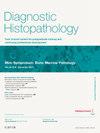An overview of pertinent immunohistochemistry and molecular pathology of phaeochromocytoma
引用次数: 0
Abstract
While morphologically distinct, immunohistochemistry for tyrosine hydroxlase is a sensitive and specific immunohistochemical marker for phaeochrmocytomas. Other useful negative routine markers include cytokeratin, melanocytic markers, TTF-1 and PAX-8. Markers that indicate specific genetic syndromic cases include succinate dehydrogenase A and B, myc-associated factor X, fumarate hydratase and 2-Succinocysteine. Prognostic markers include: Ki-67, p53, heat shock protein-90, TERT and N-cadherin. Hereditary phaeochromocytomas with germline gene mutations are grouped into several pathways: pseudohypoxia, kinase signalling, wnt signalling, mitochondrial pathways and miscellaneous. Key genes in these pathways include: HRAS, HIF2A, RET and NF1. Prognostic genes are SDHB, ATRX and TERT. Understanding the pathological, immunohistochemical and genetic landscape of phaeochromocytomas enables a multimodal approach to determining behaviour and targeted therapy.
嗜铬细胞瘤的相关免疫组织化学和分子病理学综述
虽然形态不同,但酪氨酸羟化酶的免疫组织化学是嗜铬细胞瘤的敏感和特异性免疫组织化学标志物。其他有用的阴性常规标志物包括细胞角蛋白、黑色素细胞标志物、TTF-1和PAX-8。表明特定遗传综合征病例的标志物包括琥珀酸脱氢酶A和B、myc相关因子X、富马酸水合酶和2-琥珀酸半胱氨酸。预后指标包括:Ki-67、p53、热休克蛋白90、TERT和N-cadherin。遗传性嗜铬细胞瘤伴种系基因突变可分为几种途径:假性缺氧、激酶信号、wnt信号、线粒体途径和其他途径。这些通路的关键基因包括:HRAS、HIF2A、RET和NF1。预后基因为SDHB、ATRX和TERT。了解嗜铬细胞瘤的病理,免疫组织化学和遗传景观,可以采用多模式方法确定行为和靶向治疗。
本文章由计算机程序翻译,如有差异,请以英文原文为准。
求助全文
约1分钟内获得全文
求助全文
来源期刊

Diagnostic Histopathology
Medicine-Pathology and Forensic Medicine
CiteScore
1.30
自引率
0.00%
发文量
64
期刊介绍:
This monthly review journal aims to provide the practising diagnostic pathologist and trainee pathologist with up-to-date reviews on histopathology and cytology and related technical advances. Each issue contains invited articles on a variety of topics from experts in the field and includes a mini-symposium exploring one subject in greater depth. Articles consist of system-based, disease-based reviews and advances in technology. They update the readers on day-to-day diagnostic work and keep them informed of important new developments. An additional feature is the short section devoted to hypotheses; these have been refereed. There is also a correspondence section.
 求助内容:
求助内容: 应助结果提醒方式:
应助结果提醒方式:


